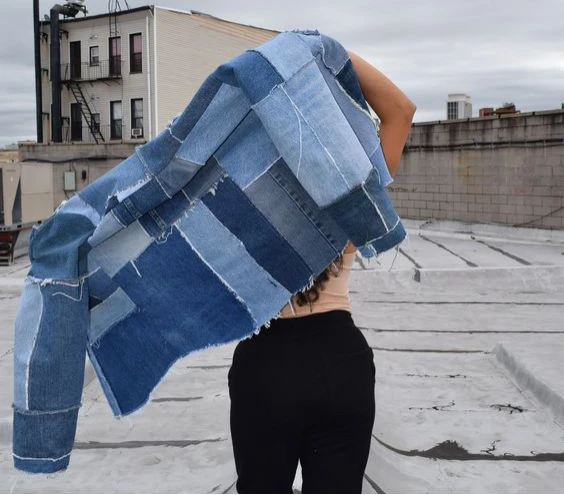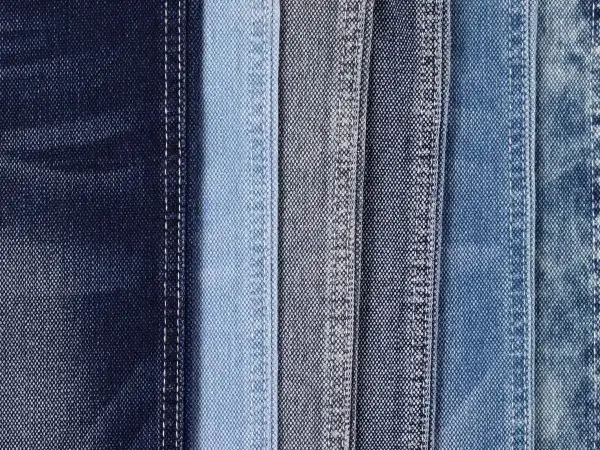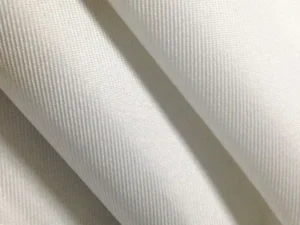Denim fabric is a popular fabric widely used to make garments such as jeans, jackets, and skirts. Some of the denim fabric also can be used to make upholstery like curtains, throw pillows, and bedspreads. Denim is strong and durable and can generally withstand years of use. Knowing more about the varieties of denim fabrics can help you make better decisions and choices when purchasing denim fabrics and upholstery fabrics. Moreover, we will write about how much denim costs in China.
In this article, we’ll discuss the various types of denim fabrics:
- How many types of denim fabric?
- How much does denim cost in China?
- What Are the Factors That Affect Denim Prices?
How Many Types of Denim Fabric?
6 Types of denim fabrics
First of all, let’s take a look at these 6 common types of denim fabric in our daily life. We will be talking about their fabric properties, advantages, and disadvantages. And also some tips on how to care for them.High-quality
-
Raw Denim
Raw denim, also known as dry denim and unsanforizing denim, this denim has not been washed or treated after the dyeing process. Raw denim is known for its stiffness and dark color. It’s often favored by denim enthusiasts for its unique, personalized fade pattern that develops over time.
-
- Advantages:
– Develop personalized fade patterns
– High-quality, durable fabric
– Can be customized according to personal preferences
-
- Disadvantages:
– Stiff and uncomfortable for the first few weeks
– Fade mode may not be what everyone wants
– Requires more care than other types of denim
-
- How to care:
– Do not wash or soak for at least six months to allow for personalized fading patterns
– When necessary, clean the area with a damp cloth or sponge
– If washing is required, turn the denim inside out and wash it in cold water
– Hang to dry, do not use the dryer
- Selvage Denim
Selvedge denim aka self-edge denim, is denim woven on traditional shuttle looms to create a self-finishing edge on both sides of the fabric. Selvage denim is often associated with high-quality denim due to the intricate weaving process.
-
- Advantages:
– High-quality, durable fabric
– Unique edge finish on both sides of the fabric
– Resistant to unraveling and abrasion
-
- Disadvantages:
– Due to the intricate weaving process, the price may be higher
– limited color options
-
- How to care:
-Turn inside out before washing
– wash in cold water
– Hang to dry, do not use the dryer
-
Stretch Denim
Stretch denim is made by adding elastane or spandex to the denim fabric. This addition provides the fabric with a comfortable stretch and a more fitted look. That is the reason why stretch jeans are becoming more and more popular because of their ability to adapt to various body types.
-
- Advantages:
– Comfortable, flexible fabric
– Can be more adapted to different body types
– Holds its shape well
-
- Disadvantages:
– Durability may be compromised due to added elastane or spandex
– May not retain its original color for as long as other types of denim
-
- How to care:
– Wash in cold water
– Use the gentle wash on the washing machine
– Hang to dry, do not use the dryer
-
Acid Wash Denim
Acid wash denim is made by washing denim in chlorine or other chemicals to give it a faded, distressed look. The process can produce a wide range of patterns and denim color variations.
-
- Advantages:
– Unique, edgy look
– Can add visual interest to clothing
– Can highlight different properties of fabrics
-
- Disadvantages:
– Is not suitable for every occasion in daily life
– Can appear cheap or excessive if not executed properly
– Harsh chemicals used in the process can damage the fabric and shorten its lifespan
-
- How to care:
– Wash in cold water
– Use the gentle wash on the washing machine
– Avoid bleach or other harsh chemicals that can further damage the fabric
-
Overdyed Denim
Overdyed denim is made by dyeing denim that has already been dyed a specific color. The process produces deep, rich colors that can be used to create unique color combinations.
-
- Advantages:
– Creates deeper, more vibrant colors than traditional dyeing processes
– Can be used to create unique color combinations
– Helps maintain the quality and longevity of denim
-
- Disadvantages:
– Color may bleed when first worn or washed
– May require more care than traditional denim due to the double dyeing process
– May be more expensive than other types of denim
-
- How to care:
– Wash in cold water alone to avoid bleeding
– Turn inside out before washing
– Hang to dry, do not use the dryer
-
Slub Denim
Slub denim is characterized by its uneven, grainy appearance. This texture is created by weaving small pieces or knots of yarn during the manufacturing process.
-
- Advantages:
– Unique appearance
– Can give garments a relaxed, casual look
– Can help hide fabric wear
-
- Disadvantages:
– Is not suitable for every occasion in daily life
– May appear overly casual or unprofessional
– Tends to snag or tear due to uneven texture
-
- How to care:
-Turn inside out before washing
– Wash in cold water
– Hang to dry, do not use the dryer
Well, you see knowing the different types of denim fabrics is essential to making an informed decision when shopping for denim clothing. Raw denim is favored for its statement, faded patterns; selvage denim for high production expense but slow production; stretch denim for its versatility and flexibility and acid-wash denim for its edginess. Overdyed denim is favored for its unique color combinations, while slub denim is favored for its textured look. Choosing the right denim fabric by knowing the pros and cons of each type of denim fabric is a wise decision. By following the right care instructions, you can extend the life of your denim garments and enjoy their unique characteristics for years to come.

Wear and tear-resistant, comfortable and stylish, this almost includes all the best quality when you choosing or buying an outfit. People may wonder how much this denim fabric costs per yard/meter. In the following paragraph, we will tackle the most popular question in the world.
How Much Does Denim in China?
Denim, a versatile fabric known for its durability, has become a timeless fashion staple. In the following part of this article, we’ll take a deep dive into the below problems:
- What are the factors that affect denim prices
- Average price ranges per meter in China
What Are the Factors That Affect Denim Prices?
-
- Fabric quality and composition
The quality of denim fabric plays an important role in determining its price. Denim made from high-quality long-staple cotton tends to be more expensive. Additionally, the inclusion of other materials such as elastane can affect the elasticity of the fabric and cause price changes.
-
- Weaving method and gram weight
Different weaving techniques such as twill and satin affect the look, texture, and durability of denim. Also, the weight of the fabric (measured in ounces per yard) affects its price. Heavier denim usually costs more because of its denser structure and greater durability.
-
- Brand and designer influence
Well-known brands and well-known designers often charge higher prices for their denim products. This can be attributed to their reputation, craftsmanship, and style expertise, resulting in higher consumer demand.
-
- Wholesale and Retail Pricing
Denim prices can vary depending on whether you buy directly from the manufacturer or through retail channels. Wholesale prices are usually lower because they are mainly open to bulk buyers, and wholesalers, while retail prices take into account additional costs such as marketing, retail space, and staffing.
-
- Location and market demand
The price of denim will vary depending on geography and market demand. Factors such as manufacturing costs, import duties, and consumer purchasing power all contribute to regional pricing differences.
Average Price Ranges per Meter in China
When we talk about average price ranges per meter in China here, what we meant is the wholesale price. And we also need to count the exchange range into consideration, that’s also one of the reasons why the fabric prices will change every month or even every two weeks.

-
- Affordable denim options
For those on a tight budget, there are affordable denim options available. Economy denim typically runs between 11 RMB and 15 RMB a meter. Yes, the price is low, and the quality of this denim is usually average to low and also is available in a variety of colors.
-
- Mid-range denim selection
Mid-range denim ranges from 16 RMB to 23 RMB a meter. Falling in this category is a good balance between quality and affordability. Fabrics generally exhibit greater durability and may have specific finishes or properties.
-
- Premium Denim Options
Premium denim, known for its exceptional quality and attention to detail, can cost between 24 RMB to 30 RMB per meter. These fabrics often feature unique weaves, finishes, and intricate designs. They are favored by denim lovers and tend to offer increased comfort and longevity.
-
- R&D denim prices
Designer denim is a sought-after category, and prices can exceed 50 RMB a yard. This premium segment is characterized by luxurious materials, innovative design, and superior craftsmanship. High price points are often associated with the exclusivity and prestige of well-known fashion brands.
Summary
The price per yard of denim depends on a variety of factors, including fabric quality, weave, brand power, pricing structure, and market demand.
By understanding these factors, consumers can make an informed decision and find denim fabrics that suit their budget and requirements. Remember that while the price is important, it is equally important to consider other factors when shopping for denim, such as fabric composition, durability, and personal style preferences.
Armed with the above information, you can confidently navigate the world of denim and its pricing while finding the perfect fabric for your needs and budget.
ZEVA DENIM, a denim fabric manufacturer in China, integrates R&D, production, and marketing. Offering 200+ classic and innovative denim products at competitive prices, small MOQ, and mostly within 7 days delivery. Also can sell denim fabrics by the yard or denim fabrics by the yard. You can click denim fabrics to learn more.
That will be all for today’s sharing, if you have any questions, please leave your comment to us. Sharing our articles will be appreciated.
Happy Reading!





